
|
 |
| . |
|
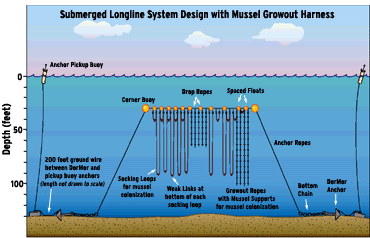 |
 |
| Click
to enlarge |
|
The mussel longline is a horizontal subsurface buoy mooring, combined with a suspended mussel growout harness. Parallel growout ropes are suspended from the longline, and growout socks are arranged in hanging loops. Weak links are installed at the bottom of the loops to allow escape, if a marine mammal should get entangled. All mooring
components are selected and sized for long term durability. The longline operates in a submerged mode to avoid the destructive effects of surface waves. The upper portion of
the longline is raised to sea level during inspection and harvest operations. Flotation is added as the growout of mussels increases the suspended weight. Separate surface guard buoys mark and protect the site. |
Submerged Coastal-Offshore Mussel Aquaculture System (SCOMAS)
Click here for pdf version
It is widely believed that the commercialization of ocean mariculture
is an area of tremendous future economic potential. In
the United States, this perceived potential exists because of an increasing
longterm trend in the per capita consumption of seafood,
limits on the output of some important commercial wild harvest
stocks, the availability of offshore locations that both minimize
the possibility of conflicts with other uses and permit operations
large enough to achieve efficient scale economies, and good water
quality, among other reasons. However, several serious scientific
questions, technological problems, and economic and policy issues
must be clarified or resolved before this potential can be realized.
As a problem of economic development with the potential to
benefit coastal communities, the central issue is one of reducing
risks arising from all of these areas to levels that improve the likelihood
of investment flows. Our broad hypothesis is that the development
of a commercially viable offshore aquaculture operation is
feasible by reducing risks in all relevant areas. More specifically, we
hypothesize that risks can be reduced substantially only through a
coordinated, interdisciplinary effort involving engineering research
on offshore structures, analysis of scientific questions concerning
biological productivity, and studies of project economics,
the workings of relevant product markets, and the clarification of
regulatory and permitting issues.
With the practical assistance of Stommel Fisheries, a commercial
fishing company based in Woods Hole, inkind support from
longline component manufacturers, including DorMor Anchors,
Fukui North America, and Seimac, and technical advice from
GRT Aquatec, Buzzards Bay Laboratory, BlueGold, American Mussel Harvesters, and Salt Water Farms, we are taking an
interdisciplinary approach to the development of a framework for
reducing the risks of ocean mariculture operations, focusing on
the production of the blue mussel (Mytilus edulis). Suspended
ocean culture of mussels is likely to result in a product of superior
taste and quality, free of pearls and toxins, and with reduced levels
of commensals and predation. We are combining offshore engineering,
biological studies, and the analysis of project economics
to characterize a technically optimized and commercially feasible
submerged suspension structure.
| WHOI Buoy Farm and Marine Mammal Sightings |
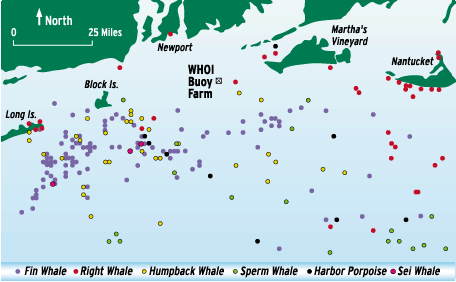 |
|
The mussel longline location (at the WHOI Buoy Farm) is shown, along with all
recorded sightings of endangered marine mammals in the area from 1965 to 1995
(Source: National Marine Fisheries Service data). Entanglement of endangered
marine animals, such as Right Whales, in aquaculture (and fishing) gear is a major
concern and may hold back the commercial development of offshore aquaculture.
The WHOI mussel longline system minimizes entanglement through built in weak
links. We have also proposed a satellite transmitter release system to notify onshore
response personnel in case of an actual entanglement. We plan to develop the entanglement
notification system with Seimac, Ltd., of Canada, as industrial partner.
|
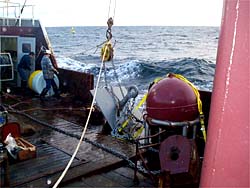 |
 |
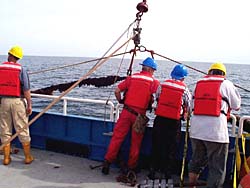 |
| Click to enlarge |
Click to enlarge |
|
Getting ready for deployment of the longline in the fall of
1998. One of the DorMor anchors and one corner buoy are seen
in the lower right; a mooring pickup buoy and its anchor are
on the left. Two 4,400 lb. DorMor anchors have been loaned to
the project by Mr. Rod Dorr. |
Inspection of longline after 8 1/2 months at sea. The 1.25-inch diameter
longline has become heavily loaded with a natural settlement of young mussels
embedded in hydroids. |
Biology (George
Hampson)
Biological processes important to the success
of an offshore mussel aquaculture operation include growth rate,
losses due to mortality and predation, and the reliability of having
abundant natural juvenile settlement.
Growth rate depends upon water temperature and the availability of food. The offshore mussel
project has been designed to monitor the growth rates of mussels
on the longline as a function of depth to test for the effect of a
“benthic turbidity zone” (BTZ).
The BTZ is a region above the seafloor
in which food particles are resuspended, providing nutrients
to mussels. The relatively warm offshore waters south of Cape Cod
provide for ideal long term mussel growing conditions and may
enable aquaculturists to grow mussels out to a marketable size in a
single season. Losses due to mortality, predation, and user conflicts
should be minimal because the mussels are isolated from both the
surface (where they are vulnerable to ducks) and the seafloor
(where they can be attacked by starfish). Finally, if the observed
natural settlement of mussel larvae at the longline site proves to
be a reliable annual event, it may be possible to eliminate the
costly step of collecting or growing larvae and putting them in
socks for growout. Don Rhoads and Jack Pearce have been providing
the principal investigators with their advice and assistance.
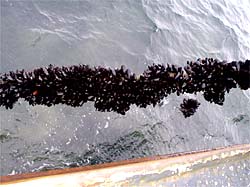 Click to enlarge
Mussel growth on the anchor lines during their retrieval on June 15, 2000. The abundance of large healthy mussels was truly amazing. These self-seeded mussels had grown during 19 months at sea.
Click to enlarge
Mussel growth on the anchor lines during their retrieval on June 15, 2000. The abundance of large healthy mussels was truly amazing. These self-seeded mussels had grown during 19 months at sea.
|
 |
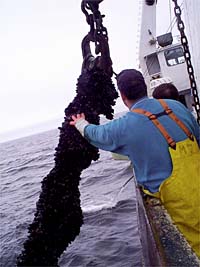 |
| Click to enlarge |
|
Another look at tremendous mussel growth found on one of the anchor lines. After stripping the mussels all ropes appeared in excellent condition.
|
Engineering (Walter
Paul)
Offshore sites are exposed to any and all
weather and sea states, requiring engineering structures that can
survive the largest wave formations at a site. The engineering program
is developing the proper design, fabrication, deployment,
service, and retrieval techniques for growing systems. Important
technical issues include low-tension cable dynamics and snap
loading, position stability and excursions of the structure under
sea state and current forcing, and acceleration levels of the mussel
payload under wave action. Relevant engineering questions include
the design of a commercially feasible and survivable longline
and mooring system; optimizing the geometry and configuration
of a harness to facilitate commercial operations (deployment,
maintenance, harvest) while minimizing stress; and specification
of best suitable mooring and longline components. Engineering
and environmental sensors with data storage capabilities may be
added, allowing comparisons of modeled and real performance. A
two-way cellular telephone or satellite communication link may be
installed, permitting near real time monitoring and instrumentation
control from a shore site. In order to make commercial mussel
farming possible and affordable, longline maintenance, husbandry,
and harvesting operations are enhanced through the practical skills
of the captain and crew of a modern commercial fishing vessel.
| Examples of Hydrodynamic Modeling of the Mussel Long-line using WHOI
Cable Software |
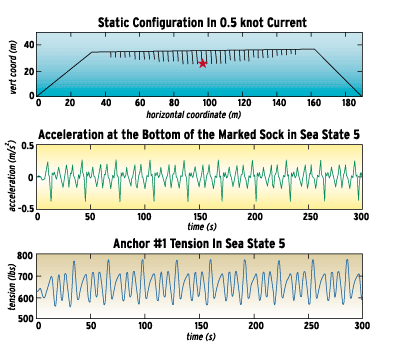 |
 |
Top: Longline under 0.5 knot axial ocean current with marked location of a
mussel sock |
 |
Center: Acceleration of the marked mussel sock under sea state 5 during a five minute time frame. The acceleration is about 1/20 th g, but is worse in
higher sea states. |
 |
Bottom: Long-Line anchor tension under sea state 5 wave forcing over a five minute exposure. (Jason Gobat, WHOI, 1998) |
Economics/Policy
(Porter Hoagland and Hauke Kite-Powell)
This component is directed at the development of a framework for evaluating the commercial
viability of offshore farming, including a discounted cash flow model of project economics, assessments of risks, and a model of supply and
demand in the mussel market. We have been successful at obtaining legal permission for the deployment of a prototype aquaculture longline
in Rhode Island Sound as a scientific research project, and we are currently in the process of applying for permission for an expanded operation
of 30 longlines.
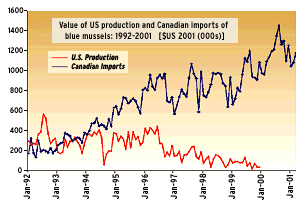
|
 |
This figure displays monthly data from 1992
through 2001 on the ex-vessel value of US
landings (wild harvest) of blue mussels and
the value of imports (mainly cultured product)
from Canada. The data include both
wild harvest landings and coastal aquaculture
production. The Canadian aquaculture
product commands a significant premium
over the wild harvest product. US production
now includes significant production (not
shown) of mussels broadcast for seabed
growout from coastal Maine.
|
| Click to enlarge |
|
This figure depicts the demand for cultured blue
mussels imported from Canada during 1997-98.
The horizontal lines represent the price of mussels
without (black) and with (red) production from a US
coastal-ocean farm. Our models predict that a full-scale
open-ocean aquaculture farm is likely to supply
enough mussels to the market to drive price
down. Note that price is variable, as there are a
number of influential factors, including the supply
of substitute shellfish and the effects of competitive
strategies. As an example of the latter, the US International
Trade Commission currently is investigating
an antidumping complaint issued by a US producer
against Canadian growers.
|
 |
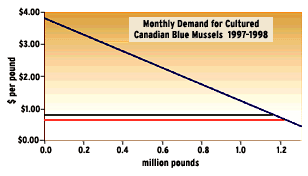
Click to enlarge
|
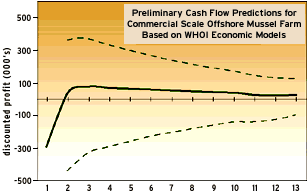
Click to enlarge
|
 |
This figure shows preliminary results from a discounted
cash flow model with confidence intervals
that depict the likelihood of profits and losses. These
results suggest that an offshore aquaculture enterprise
is marginally profitable at an average market
price of live, processed product at $0.64 per pound
(the price that results from the demand model when
a US coastal-ocean farm comes on line). This price
currently exceeds the price for wild harvest mussels,
but it is well below the average price per pound for
aquaculture product imported from Canada. Model
assumptions include: a field of 300 longlines, with
25 socks per longline, worked by a moderate-sized
scalloper; a two-year growout from natural set; each
longline lasts 10 years; each longline is maintained
three times and harvested once during the two-year
growout. The hypothetical aquaculture operation
produces about 656 tons of mussels per year, which
is equivalent to the current average monthly supply
of mussels into the US market (i.e.,
about one-twelfth the annual output).
|
We gratefully acknowledge the sponsorship and assistance of a number of individuals and organizations.
Funding for SCOMAS has been received from the Woods Hole and MIT Sea Grant programs, the Massachusetts Aquaculture Grants program, the WHOI Marine Policy Center, and internal WHOI sources. Dr. John Bonardelli of GRT Aquatec, who has developed large-scale blue mussel growout longlines in Quebec, has provided helpful suggestions and support.
Don Bishop of Fukui North America donated mussel socks, Rod Dorr of DorMor Anchors lent us anchors, Aubrey Consulting contributed with diving services, and Matt Stommel of Stommel Fisheries has assisted us with the deployment and retrieval of equipment.
|

|

